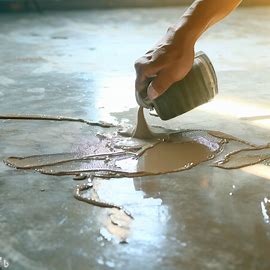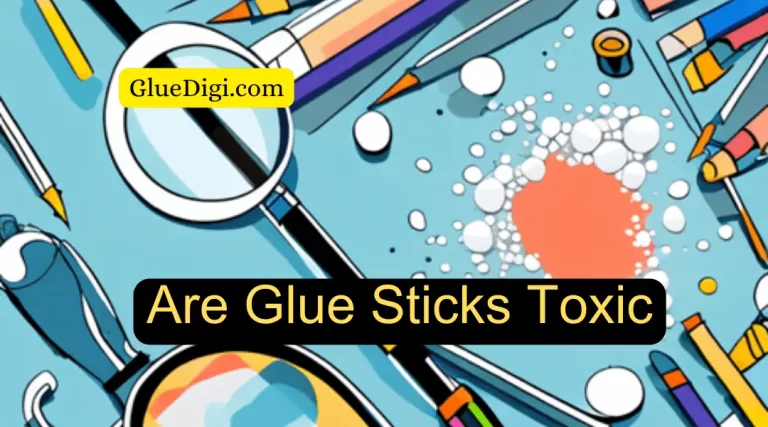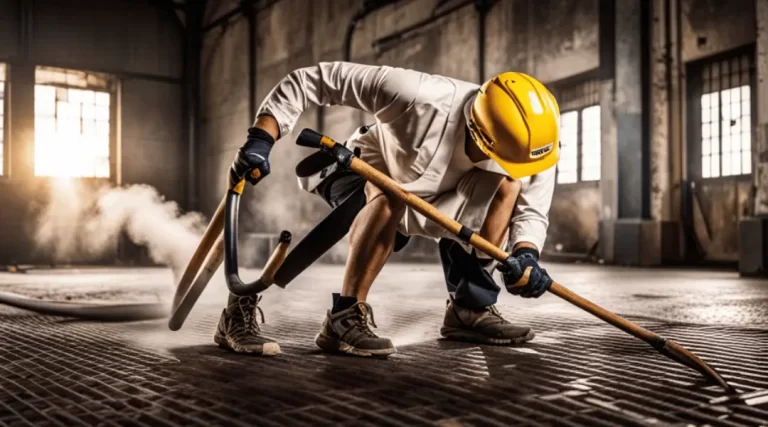Flooring glue can be a stubborn and challenging substance to remove from concrete floors. This adhesive is often used to secure vinyl, carpet, and hardwood flooring to the surface of the concrete. It is a durable and long-lasting adhesive that is designed to withstand the wear and tear of everyday use. However, when it is time to remove the flooring or renovate the space, the glue can become a significant obstacle.
It can leave behind a residue that is difficult to remove, making it challenging to prepare the surface for a new flooring application. Fortunately, there are several techniques that can be used to effectively remove flooring glue from concrete floors. These techniques range from using chemical adhesive removers to natural remedies and pressure washing.
Each method has its unique advantages and disadvantages, and the choice of technique will depend on the type and amount of glue to be removed, as well as personal preferences and safety considerations. In this article, we will explore some of the most effective techniques for removing flooring glue from concrete floors, providing you with the knowledge and insight you need to tackle this challenging task with confidence and ease.
Prepare the Area
Prior to beginning the removal process, it is crucial to adequately prepare the surrounding area to ensure minimal damage and maximum efficiency.
This includes covering any surrounding surfaces and objects with protective materials, such as plastic sheets or drop cloths, to prevent damage from the removal process.
It is also important to remove any obstacles from the area, such as furniture or appliances, to allow for easy access to the entire floor.
By taking these steps, the removal process can be completed more efficiently and with less risk of damage to the surrounding area.
Once the area is properly prepared, the next step is to scrape and sand the surface to effectively remove the flooring glue.
Scrape and Sand the Surface
The process of scraping and sanding the surface of the concrete floor proves to be a labor-intensive yet necessary step in achieving a smooth and polished finish.
Handheld tools such as scrapers and sanders are effective in removing the flooring glue and adhesive residue. However, it is crucial to wear protective gear such as gloves and masks to avoid inhaling the dust particles.
Chemical solvents can also be used to soften the glue and make it easier to scrape off. It is important to follow safety precautions and instructions when using these solvents.
Once the surface is scraped and sanded, it is ready for the next step of using a heat gun to soften the remaining glue and adhesive for easier removal.
With these techniques, the concrete floor can be restored to its original state, providing a clean and functional space for any purpose.
Use a Heat Gun
Using a heat gun is a crucial step in preparing the surface of the concrete floor for polishing and achieving a smooth finish. It is a helpful technique for removing flooring glue from concrete floors that cannot be removed by scraping and sanding.
However, it is important to take heat gun safety measures seriously, such as wearing protective gear, using a power strip equipped with a circuit breaker, and avoiding flammable materials. It is also important to note that alternative heat sources, such as a blowtorch or open flame, should not be used as they can damage the concrete or create a fire hazard.
By using a heat gun correctly, it softens the adhesive, making it easier to remove with a scraper or putty knife. Once the adhesive is removed, the next step is to apply a chemical adhesive remover to ensure all residue is removed before polishing the concrete floor.

Apply a Chemical Adhesive Remover
Applying a chemical adhesive remover is a necessary step in the process of preparing a concrete floor for polishing, as it ensures that all adhesive residue is removed and the surface is ready for further treatment.
Chemical adhesive removers are readily available in the market and are designed to break down the glue, making it easier to remove. However, it is important to take safety precautions when using these chemicals as they can be harmful when inhaled. It is recommended to use a respirator and work in a well-ventilated area to avoid vapour inhalation.
Additionally, it is important to consider the environmental impact of using chemical adhesive removers and dispose of them properly to avoid contaminating the environment.
Once the adhesive remover has been applied and the glue has been removed, it is recommended to try natural remedies such as vinegar or baking soda to further clean the surface and prepare it for polishing.
Try Natural Remedies
Utilizing alternative cleaning solutions can offer a more environmentally conscious approach to eliminating residual substances and further readying the concrete surface for the subsequent polishing treatment.
DIY alternatives and eco-friendly options can provide an effective solution for removing flooring glue from concrete floors without the use of harsh chemicals.
For example, vinegar and baking soda can be mixed together to create a natural cleaning solution that can break down the glue. Alternatively, using a mixture of hot water and dish soap can also help to loosen the glue.
These natural remedies not only help to protect the environment but can also save money on expensive chemical cleaners. However, it’s important to note that these methods may not be as effective as chemical cleaners and may require more effort and time.
With that being said, it’s important to consider all options before deciding on the best approach for removing flooring glue.
Moving forward, using a pressure washer can be an effective way to remove any remaining glue and prepare the surface for further treatment.
Use a Pressure Washer
The application of high-pressure water streams in concrete surface preparation has gained popularity in recent years, with a study reporting that pressure washing can remove up to 99% of surface contaminants.
Pressure washing is an effective technique for removing flooring glue from concrete floors, as it can blast away the adhesive residue without damaging the concrete surface. However, there are also some cons to consider.
For instance, if the pressure is too high, it can cause pockmarks and other damage to the concrete surface, which can be difficult to repair. In addition, pressure washing can be time-consuming and messy, and it requires specialized equipment and protective gear.
To ensure the best results, it is essential to follow some best practices, including using the appropriate pressure setting, prepping the surface before pressure washing, and using a detergent or degreaser for stubborn glue residue.
After pressure washing, it is important to finish the surface by smoothing out any rough spots and applying a concrete sealer to protect against future damage.
Finish the Surface
To ensure a smooth and lasting finish on your concrete floor, it is imperative to clean the surface thoroughly before applying any sealant or primer. This will remove any remaining debris and ensure that the surface is ready for the next step.
Applying a concrete sealer or primer will help to prevent future damage to the floor and provide an even surface for the new flooring to be installed.
Finally, once the sealant has fully cured, you can install your new flooring with confidence, knowing that it will have a solid foundation to rest upon.
Clean the Surface Thoroughly
Thoroughly cleaning the surface is an essential step in preparing the concrete floor for future use. Deep cleaning is necessary to remove any remaining glue residue, dirt, and debris.
The surface preparation involves using a combination of specialized chemicals and mechanical scrubbing to remove the glue effectively. By removing all traces of the adhesive, the surface will be ready for the next step, which is applying a concrete sealer or primer.
The sealer or primer will help to protect the concrete surface from any future damage, and it will also help to ensure that the surface is suitable for the intended use. Ultimately, the key to removing flooring glue from concrete floors is to clean the surface thoroughly to achieve the desired results.
Apply a Concrete Sealer or Primer
Applying a concrete sealer or primer is a critical step in protecting the concrete surface and ensuring its suitability for future use. Studies show that a properly sealed concrete surface can last up to 25 years.
The benefits of sealing include protecting the concrete from damage and stains, improving its appearance, and making it easier to clean. When selecting a primer, it is important to consider the type of flooring that will be installed on top of it.
Common mistakes when applying sealer or primer include not properly preparing the surface, applying too much or too little, and not allowing enough drying time. It is essential to follow the manufacturer’s instructions carefully and use the appropriate application tools.
Once the sealer or primer is applied and allowed to cure, the concrete surface will be ready for installing new flooring.
Install New Flooring
The installation of new flooring on a properly primed and sealed concrete surface is a crucial step in ensuring longevity and durability of the floor.
When considering flooring options, it is important to take into account budget considerations and choose a material that suits your needs and aesthetic preferences.
Some popular flooring options for concrete floors include hardwood, laminate, vinyl, and tile.
Hardwood flooring can give a classic and timeless look, while laminate and vinyl can mimic the appearance of hardwood at a lower cost.
Tile is durable and perfect for high traffic areas, but can be more expensive than other options.
Ultimately, the choice of flooring will depend on personal taste and budget, but it is important to remember that a well-installed and maintained floor can add value to your home and provide a sense of freedom and comfort.
Conclusion
When it comes to removing flooring glue from concrete floors, there are various techniques available. It is important to take necessary precautions before starting the process. This includes wearing protective gear and ensuring that the area is properly ventilated.
Scraping and sanding the surface is one of the most common methods to remove glue from concrete floors. However, it can be time-consuming and labor-intensive.
Another effective approach is to use a heat gun. This method softens the glue, making it easier to scrape off. Applying a chemical adhesive remover is also a viable option. However, one must be careful while using chemicals and should follow the instructions carefully. Natural remedies like vinegar, baking soda, or lemon juice can also be used as an alternative to chemical removers.
According to a recent survey, nearly 25% of homeowners in the US face the challenge of removing flooring glue from concrete floors. This highlights the need for effective techniques that can simplify the process. Using a pressure washer can also help to remove the glue, but one must be careful not to damage the concrete surface.
Finally, it is important to finish the surface after removing the glue. This can be done by sanding, polishing, or applying a new coat of concrete sealer.
In conclusion, removing flooring glue from concrete floors can be a daunting task. However, with the right techniques and tools, it can be simplified. It is important to choose the method that suits your specific needs and follow the necessary precautions. By doing so, you can achieve a clean and smooth concrete surface that looks as good as new.





